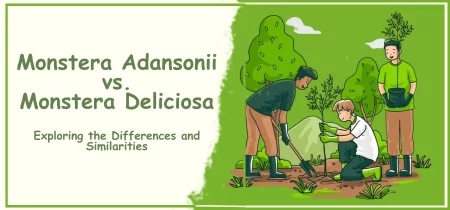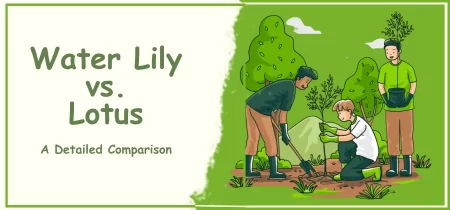In recent years, houseplants have become an increasingly popular way to enhance interior design and bring nature into our homes. In this article, we will explore the differences between Brazil Pothos and Philodendron so that you can make an informed decision.
Let’s dive in!
Understanding the Basics: Overview of Brazil Pothos and Philodendron
When choosing houseplants, two popular options are Brazil Pothos and Philodendrons. These plants are often compared, but they have distinct differences that make them unique.
Let’s take a closer look at both plants’ physical characteristics and growth patterns.
Physical Characteristics of the Plants
Brazil Pothos and Philodendrons have differences. Brazil Pothos has heart-shaped leaves, while Philodendron leaves are elongated and narrow. Brazil Pothos leaves have a glossy texture, while Philodendron leaves are often matte.
Both plants have a variety of leaf colors and patterns. Brazil Pothos typically has variegated leaves with shades of green, yellow, and white. Philodendron leaves can be solid green or variegated, with different shades of green and yellow.
Differences in Leaf Shape and Size
Another significant difference between Brazil Pothos and Philodendrons is their leaf shape and size. Brazil Pothos has small heart-shaped leaves that grow on long, slender stems.
Philodendron has larger, elongated leaves that can grow several feet long. The leaves of Philodendrons often have a “spear-or arrow-shaped shaped.”
Growth Patterns of Both Plants
Brazil Pothos and Philodendron are vining plants that can grow several feet long if given the right conditions.
Brazil Pothos tends to grow compactly and is a great option for hanging baskets or small bushy spaces. Philodendrons can grow quite tall and may need support to keep them upright.
In my personal experience, Brazil Pothos is a great plant for beginners because it is relatively easy to care for and grows quickly.
Its compact size also makes it an excellent option for small apartments or offices. Philodendron, while also relatively easy to care for, requires more space and attention due to its larger size.
Overall, understanding the basics of Brazil Pothos vs. Philodendron is essential when deciding which plant is right for you.
Consider your space, lighting conditions, and care requirements before making your choice. In the next section, we will explore the different light requirements of Brazil Pothos and Philodendrons.
Light Requirements:
Sunlight is a crucial factor to consider when choosing a spot for your Brazil Pothos or Philodendron. These plants require different levels of light to thrive, and it’s essential to understand their needs to ensure healthy growth.
Sunlight Needs of Brazil Pothos:
Brazil Pothos is a low-light plant that can thrive in a range of lighting conditions, from low to bright indirect light. However, direct sunlight can scorch its leaves, leading to brown patches. I prefer keeping my Brazil Pothos in a spot that receives bright, indirect light, like near a north-facing window.
Sunlight Needs of Philodendron:
Philodendron, on the other hand, thrives in bright, indirect light. It can tolerate some direct sunlight, but prolonged exposure can lead to leaf damage. Keeping my Philodendron near an east-facing window is ideal, as it receives morning sun and bright, indirect light throughout the day.
The Impact of Light on Plant Growth:
Light plays a crucial role in the growth and development of plants. It’s essential for photosynthesis, the process through which plants convert light into energy. Lack of sunlight can result in stunted growth, yellowing leaves, and even death.
Choosing the Right Spot for Your Plant:
When choosing a spot for your Brazil Pothos or Philodendron, it’s essential to consider their light requirements.
Take note of the lighting conditions in different areas of your home and observe how much light they receive throughout the day. Find a spot that receives the right amount of light for your plant’s needs, and watch it thrive!
Watering and Humidity:
Watering and humidity are among the most important aspects of caring for houseplants like Brazil Pothos and Philodendron.
Proper watering and humidity levels can mean the difference between a healthy, thriving plant and a sad, wilted one. Here are some tips to help you care for your Brazil Pothos and Philodendron:
Watering Needs of Brazil Pothos:
Brazil Pothos prefer to have moist soil but prefer to avoid being waterlogged. It’s important to allow the top inch of soil to dry out between waterings. When it’s time to water, I make sure to give it a good soak until water drains out of the bottom of the pot.
Watering Needs of Philodendron:
Philodendrons also prefer moist soil, but they can handle a bit more drying out between waterings than Brazil Pothos. I typically water my Philodendron when the top 2-3 inches of soil feel dry to the touch.
Humidity Requirements for Optimal Growth:
Brazil Pothos and Philodendron are tropical plants and thrive in environments with high humidity. To help them grow and stay healthy, I like to mist them with water a few times a week or place a humidifier near them.
Signs of Overwatering and Underwatering:
Overwatering can lead to root rot and other issues, while underwatering can cause wilting and stunted growth. Signs of overwatering include yellowing leaves, soft stems, and a bad smell from the soil. Signs of underwatering include wilting, brown edges on the leaves, and dry soil.
By following these tips, you can ensure that your Brazil Pothos and Philodendron are well-watered and enjoying the optimal humidity levels for their growth and health.
Soil and Fertilizer:
Choosing the Right Soil for Your Plant:
When it comes to Brazil’s Pothos and Philodendron both require well-draining soil that retains moisture without getting too soaked. I have found that a mixture of peat moss, perlite, and vermiculite works well for both plants.
Fertilizing Your Brazil Pothos:
Brazil Pothos plants are not heavy feeders, so it is best to fertilize them sparingly. I prefer to use a balanced, water-soluble fertilizer with equal parts nitrogen, phosphorus, and potassium. During the growing season, I fertilize my Brazil Pothos every four to six weeks.
Fertilizing Your Philodendron:
Philodendrons are moderate feeders and can benefit from a balanced fertilizer with slightly more nitrogen than phosphorus and potassium. During the growing season, I fertilize my Philodendron every two to three weeks.
Common Mistakes to Avoid:
Some people need to correct things regarding soil and fertilizer. This can lead to nutrient burn and can be harmful to your plant. Another mistake is using too dense soil that does not allow for proper drainage.
This can lead to root rot and other issues. Choose a soil and fertilizer specifically designed for your plant’s needs.
Choosing the right soil and fertilizer is crucial for the health and growth of your Brazil Pothos and Philodendron plants. With a little bit of research and some trial and error, you can find the perfect combination that works for your plants.
Propagation:
Propagation is a fantastic way to expand your collection of Brazil Pothos or Philodendrons without spending a lot of money on buying new plants. In this section, we’ll explore how to propagate each of these plants.
Propagating Brazil Pothos
Brazil Pothos are quite easy to propagate and can be done through stem cuttings. To do this, follow these steps:
- Cut a healthy stem from the parent plant with at least two nodes (where the leaves attach to the stem).
- Place the stem cutting in a jar of water, ensuring that at least one node is submerged.
- Place the jar in a warm, bright spot, but not in direct sunlight.
- Change the water every week to prevent bacterial growth.
- After a few weeks, you’ll notice roots growing from the node in the water.
- Once the roots are around an inch long, you can transfer the cutting to a pot filled with potting mix.
Propagating Philodendron
Philodendrons can be propagated through stem cuttings, but you can use a few different methods. Here is one simple way:
- Cut a healthy stem from the parent plant, ensuring it has at least two nodes.
- Remove the bottom set of leaves to create a bare stem section.
- Dip the cut end in rooting hormone (optional but recommended).
- Place the cutting in a pot filled with potting mix and water thoroughly.
- Cover the pot with a plastic bag or container to create a humid environment.
- Place the pot in a warm, bright spot, but not in direct sunlight.
- After a few weeks, roots will start to grow from the cut end, and new leaves will begin to emerge.
Step-by-Step Guide to Propagation
Here’s a general step-by-step guide to propagating both Brazil Pothos and Philodendron:
- Take a healthy stem cutting from the parent plant.
- Prepare the cutting according to the instructions for the specific plant.
- Place the cutting in the appropriate rooting medium (water or soil).
- Provide the cutting with the necessary light and humidity.
- Wait for roots to grow and new leaves to emerge.
- Transfer the new plant to a pot filled with potting mix once it has established roots.
Tips for Success
- Use a sharp, sterile tool to make the cutting.
- Keep the cutting in a warm, bright spot, but not in direct sunlight.
- Change the water for water-propagated cuttings every week to prevent bacterial growth.
- Use rooting hormone for soil-propagated cuttings to encourage root growth.
- Keep the soil moist but not waterlogged.
- Patience is key! Propagation can take several weeks or even months to establish roots and new growth.
Pests and Diseases
Brazil Pothos and Philodendrons are not only beautiful plants, but they’re also quite hardy. However, like all plants, they are susceptible to pests and diseases that can cause significant damage if left untreated.
I’ll discuss some of the most common pests and diseases that affect Brazil Pothos and Philodendrons and how to identify and treat them.
Common Pests Affecting Brazil Pothos:
The most common pests affecting Brazil Pothos are spider mites, mealybugs, and scale insects.
Spider mites are tiny pests that can cause yellowing and speckling of the leaves, while mealybugs and scale insects are small insects that feed on plant sap and excrete a sticky substance called honeydew, which can attract ants and cause fungal infections.
You can use insecticidal soap or neem oil spray to treat spider mites. Mealybugs and scale insects can be removed manually or with insecticidal soap or neem oil spray.
Common Pests Affecting Philodendron:
Philodendrons are also susceptible to spider mites, mealybugs, and scale insects. They are also prone to thrips and aphids. Thrips are tiny insects that can cause discoloration and distortion of the leaves, while aphids are small insects that feed on plant sap and excrete honeydew.
You can use an insecticidal soap or neem oil spray to treat thrips and aphids. Mealybugs and scale insects can be removed manually or with a block of insecticidal soap or neem oil spray.
How to Identify and Treat Pests:
The first step in identifying pests is to inspect your plants regularly for any signs of damage. Look for discolored or distorted leaves, webbing, or sticky residue on the leaves or stems. Once you have identified the pest, you can treat it with an appropriate insecticide.
Common Diseases and How to Prevent Them:
One of the most common diseases affecting Brazil Pothos and Philodendrons is root rot. This is caused by overwatering or poorly-draining soil, which can lead to fungal infections. To prevent root rot, make sure your plant is in well-draining soil and avoid overwatering.
Another common disease is leaf spot, which is caused by fungal infections. This can be treated by removing infected leaves and treating the plant with a fungicide.
While Brazil Pothos and Philodendrons are hardy plants, they are not immune to pests and diseases. Regular inspections and appropriate treatment can help keep your plants healthy and beautiful for years.
Decorating with Brazil Pothos and Philodendron:
Incorporating Plants into Your Home Decor
I love incorporating plants into my home decor, and Brazil Pothos and Philodendrons are two of my favorites. These plants are easy to care for and add a touch of greenery to any space, making it feel more lively and inviting.
When incorporating plants into your home decor, it’s important to consider the style of your space and how the plants will fit in. Brazil Pothos and Philodendron are versatile plants that can work well with various interior styles.
Brazil Pothos and Philodendron in Different Interior Styles
If you have a modern or minimalist space, consider a sleek white planter to showcase the plants’ beautiful green leaves. The simplicity of the planter will complement the clean lines and neutral tones of the space.
For a bohemian or eclectic space, try hanging Brazil Pothos or Philodendrons in macrame plant hangers. This will add a touch of texture and movement to the room, creating a relaxed and comfortable atmosphere.
If your home decor style is more traditional, consider a classic terracotta planter for your Brazil Pothos or Philodendron. The planter’s warm color and earthy texture will add charm and coziness to the space.
Tips for Choosing the Right Planter
When choosing a planter for your Brazil Pothos or Philodendron, it’s important to consider the plant’s needs. These plants prefer well-draining soil, so choose a planter with drainage holes to prevent water from accumulating and causing root rot.
Also, consider the size of the plant and choose a planter that is appropriate for its current size. A planter that is too large can cause overwatering and other issues, while a planter that is too small can cause the plant to become root-bound and stunt its growth.
Incorporating Brazil Pothos and Philodendron into your home decor is a great way to add a touch of nature to your space while also enjoying the many benefits of indoor plants. Whether you have a modern, bohemian, or traditional space, these versatile plants can work well with various interior styles.
Frequently Asked Questions
Do Brazil Pothos and Philodendron require similar growing conditions?
While both plants prefer bright, indirect light and well-draining soil, Philodendron tends to thrive in higher humidity than Brazil Pothos.
Can Brazil Pothos and Philodendron tolerate low light conditions?
Both plants can survive in lower light conditions, but their growth may slow down or become leggy.
What is the difference between the root systems of Brazil’s Pothos and Philodendron?
Brazil Pothos has a more fibrous root system, while Philodendron has a more extensive root system that can grow quite large.
How often should I water my Brazil Pothos or Philodendron?
Watering frequency depends on several factors, such as the size of the plant, the type of soil, and the humidity levels. Generally, it is best to allow the top inch of soil to dry out before watering.
Can Brazil Pothos and Philodendron be propagated in the same way?
Yes, both plants can be propagated through stem cuttings, but Philodendrons can also be propagated through division.
Are Brazil Pothos and Philodendrons susceptible to any specific pests or diseases?
Yes, both plants can be susceptible to mealybugs, spider mites, and fungal diseases such as root rot. It is essential to monitor your plants regularly for any signs of pests or diseases and take appropriate action.
Conclusion
In conclusion, Brazil Pothos and Philodendron are wonderful houseplants that can add a touch of greenery to any space. While they share some similarities in care and maintenance, there are key differences between the two plants that should be considered when deciding which one is right for you.
Brazil Pothos may be the perfect choice if you are looking for a low-maintenance plant that is easy to propagate and can thrive in various lighting conditions.
On the other hand, if you are looking for a larger plant with striking foliage and the ability to climb, Philodendron may be a better option.
Ultimately, the decision between Brazil Pothos and Philodendron comes down to personal preference and the specific needs of your home environment.
Whichever plant you choose, remember to provide it with the proper care, including the right amount of light, water, and nutrients.
So why not start or expand your houseplant collection today? With their beauty and numerous benefits, Brazil Pothos and Philodendron are sure to be a great addition to any home.




Leave a Reply